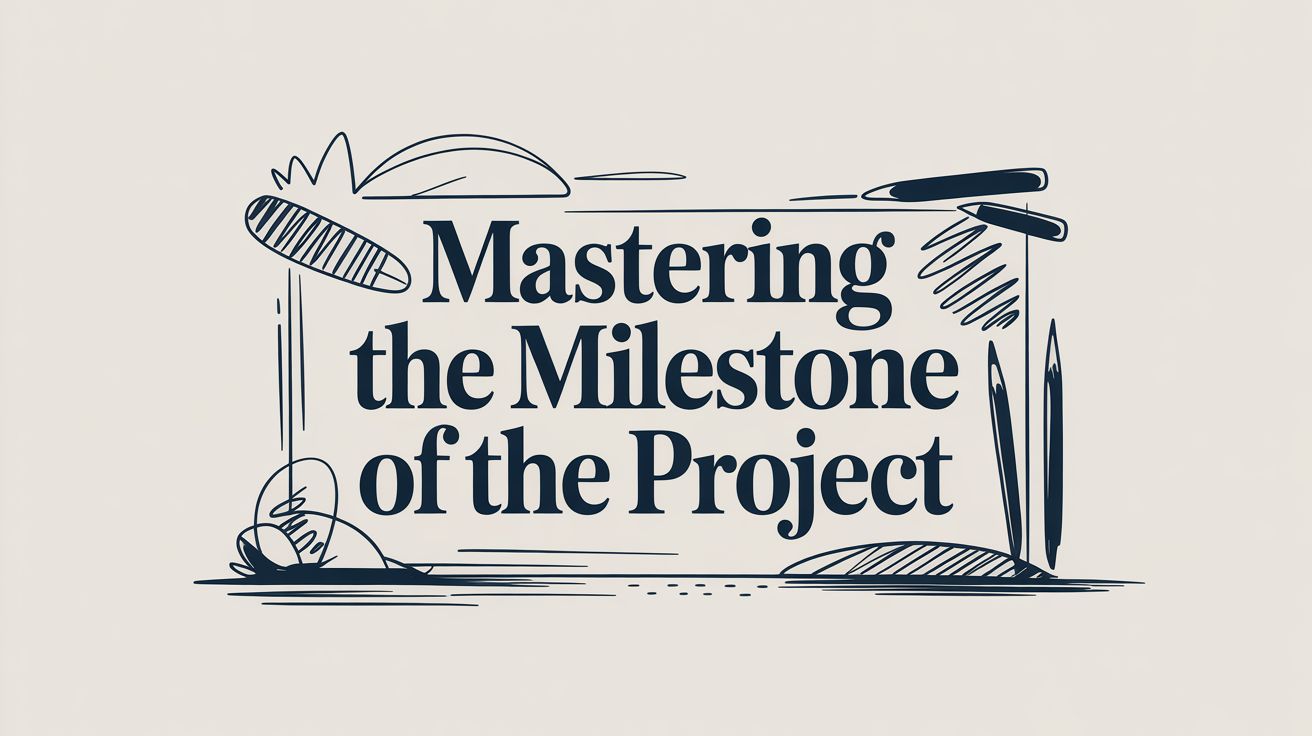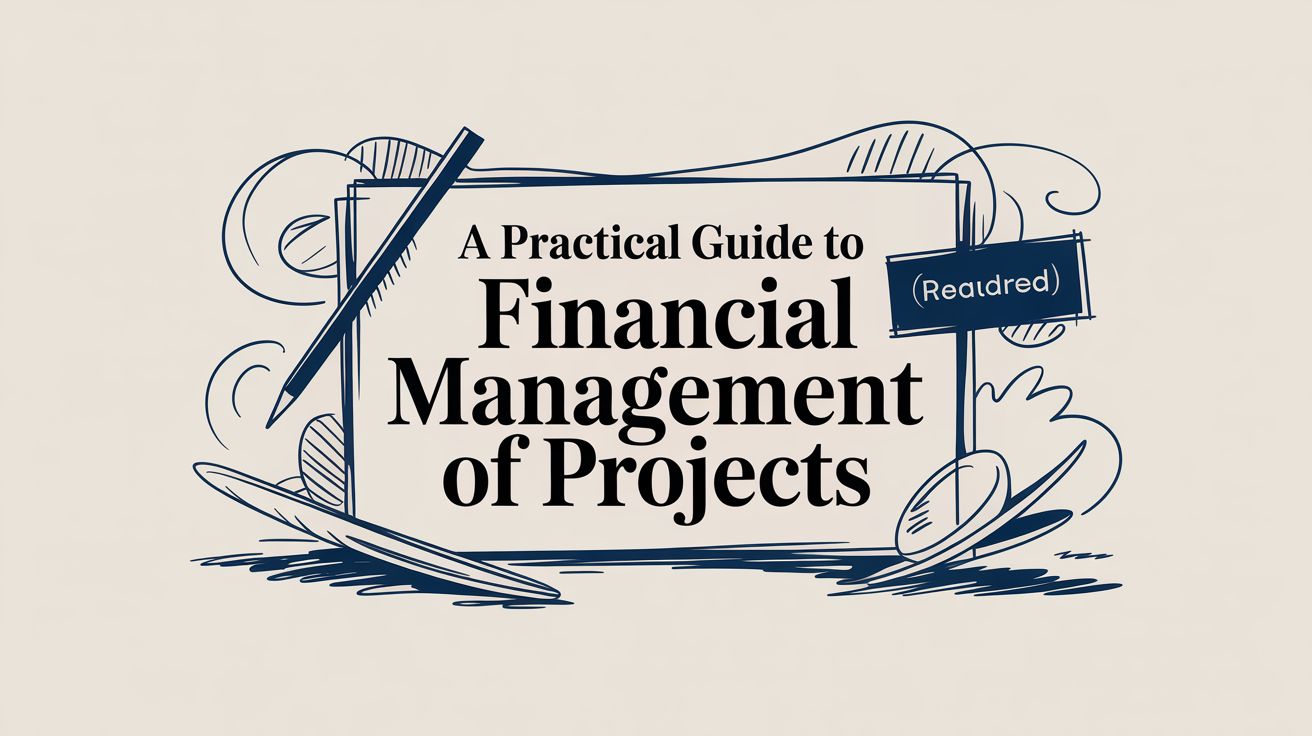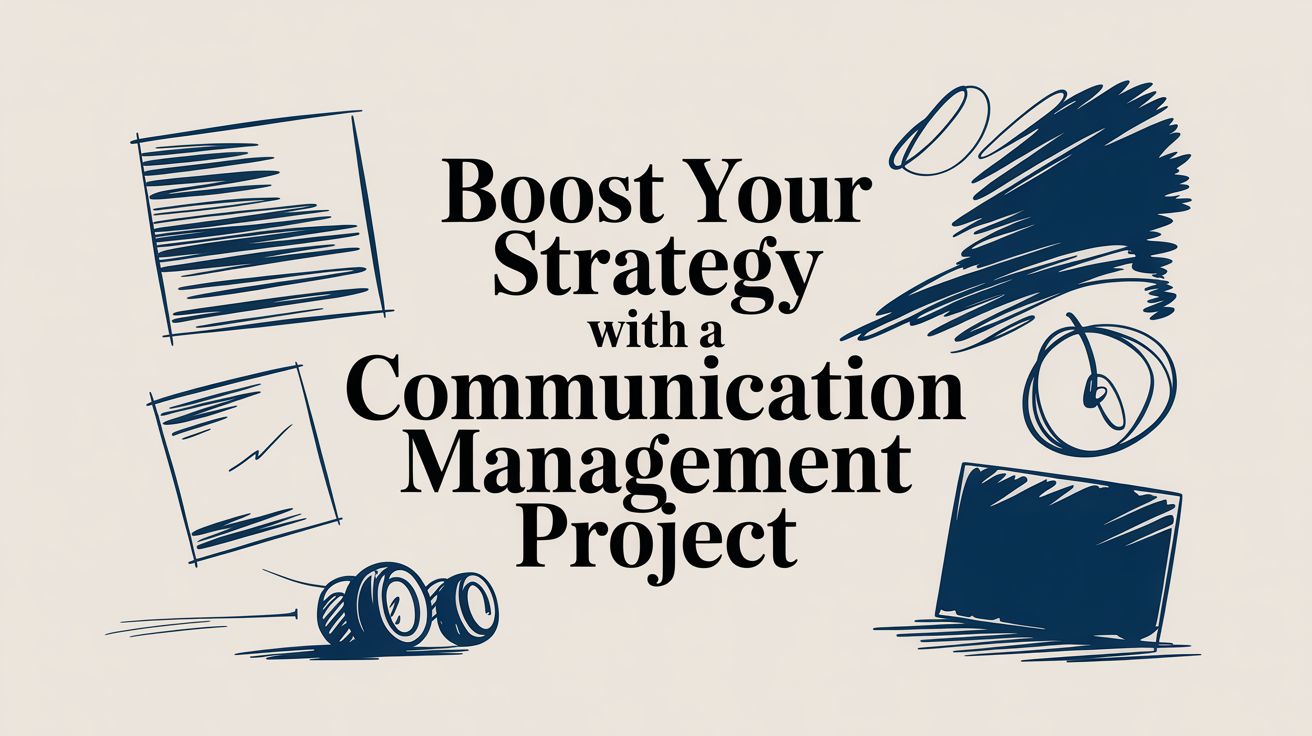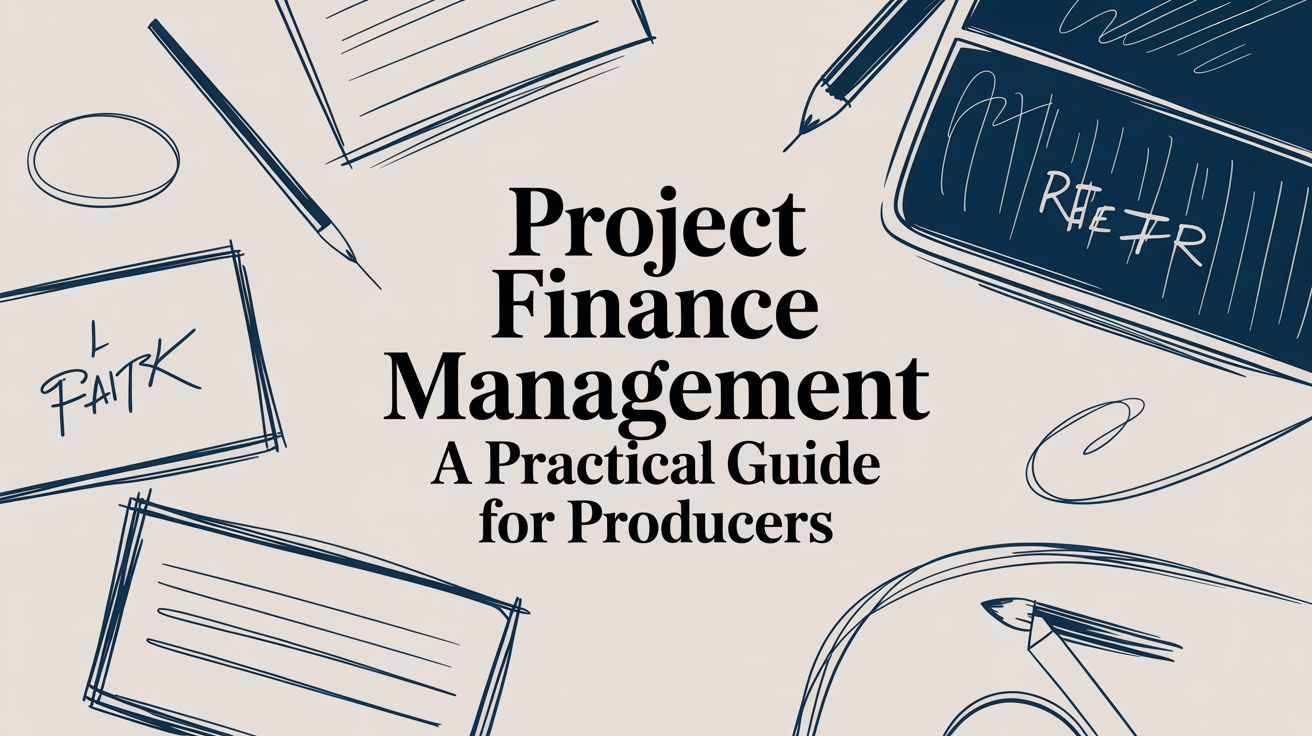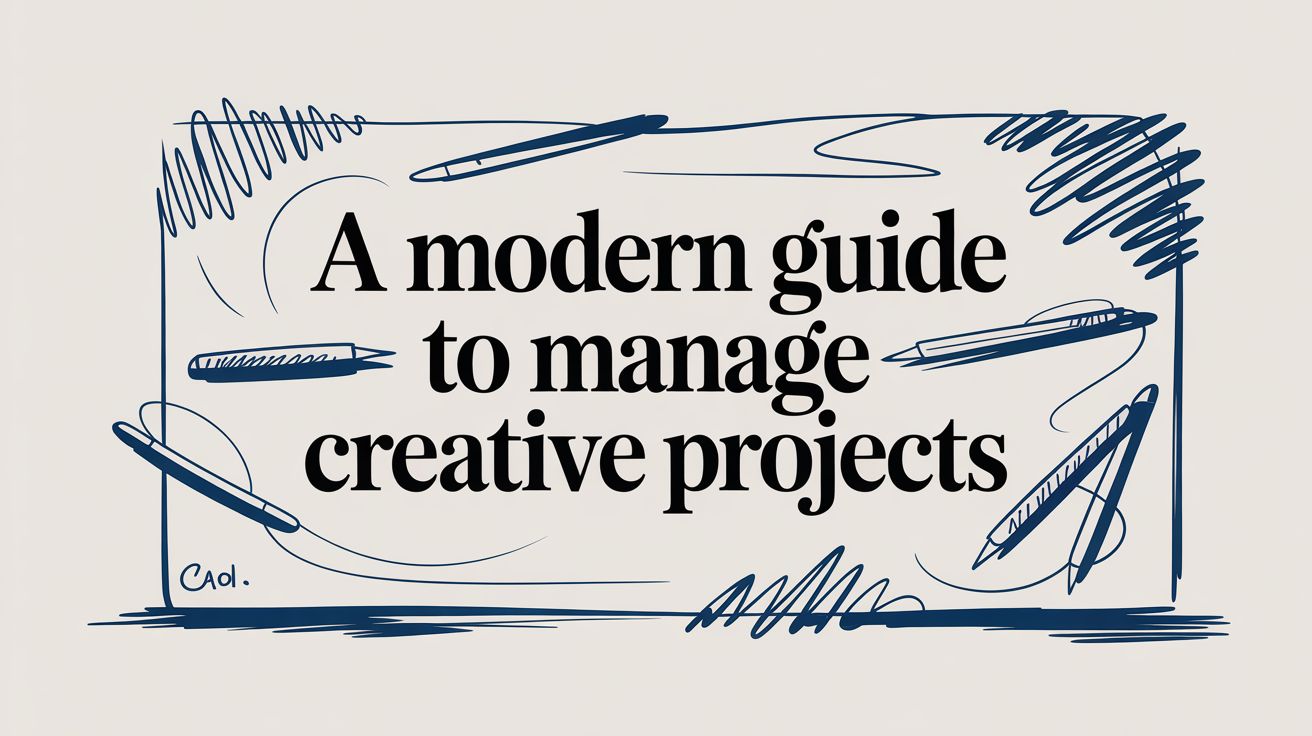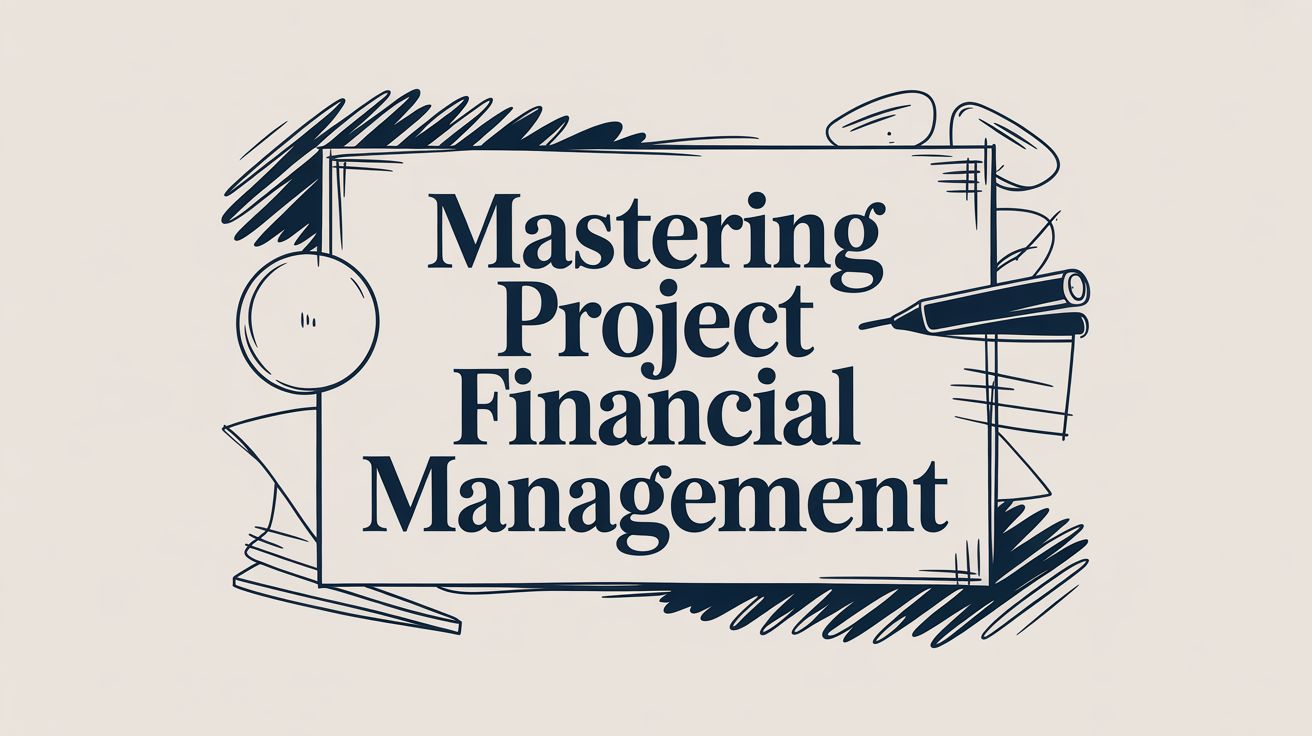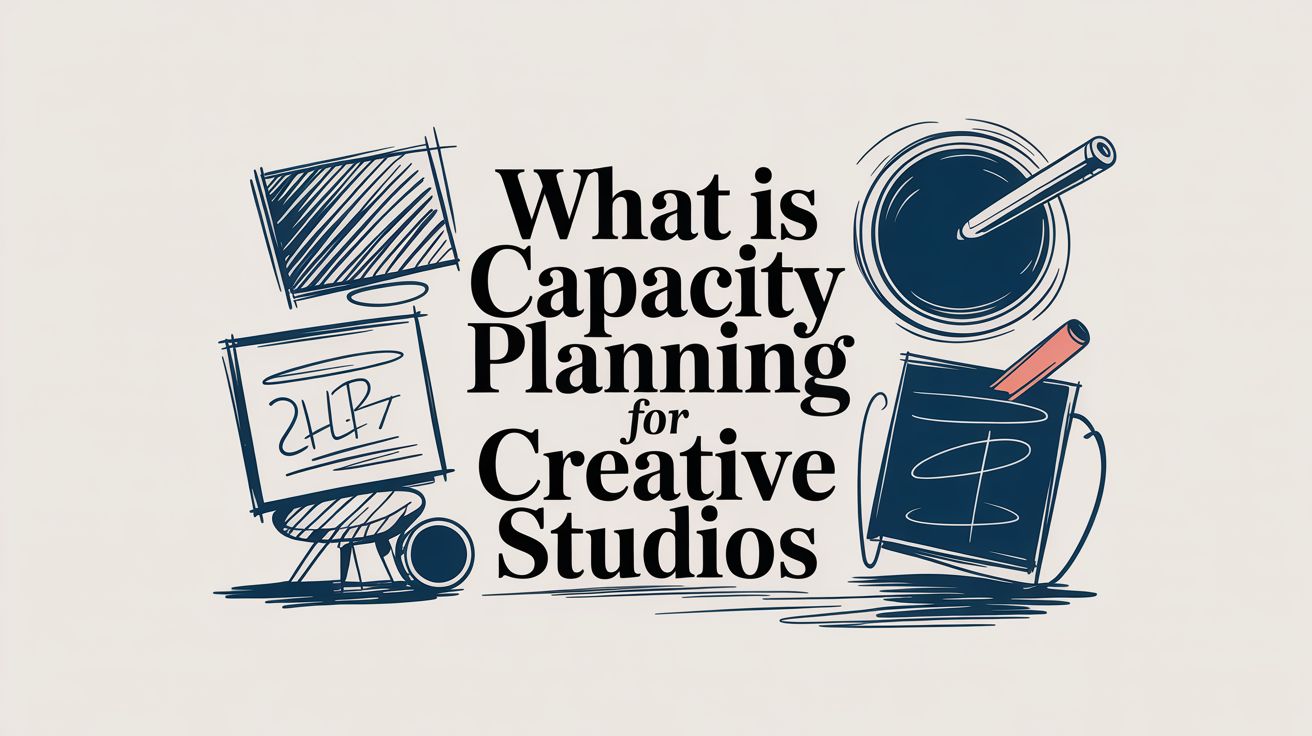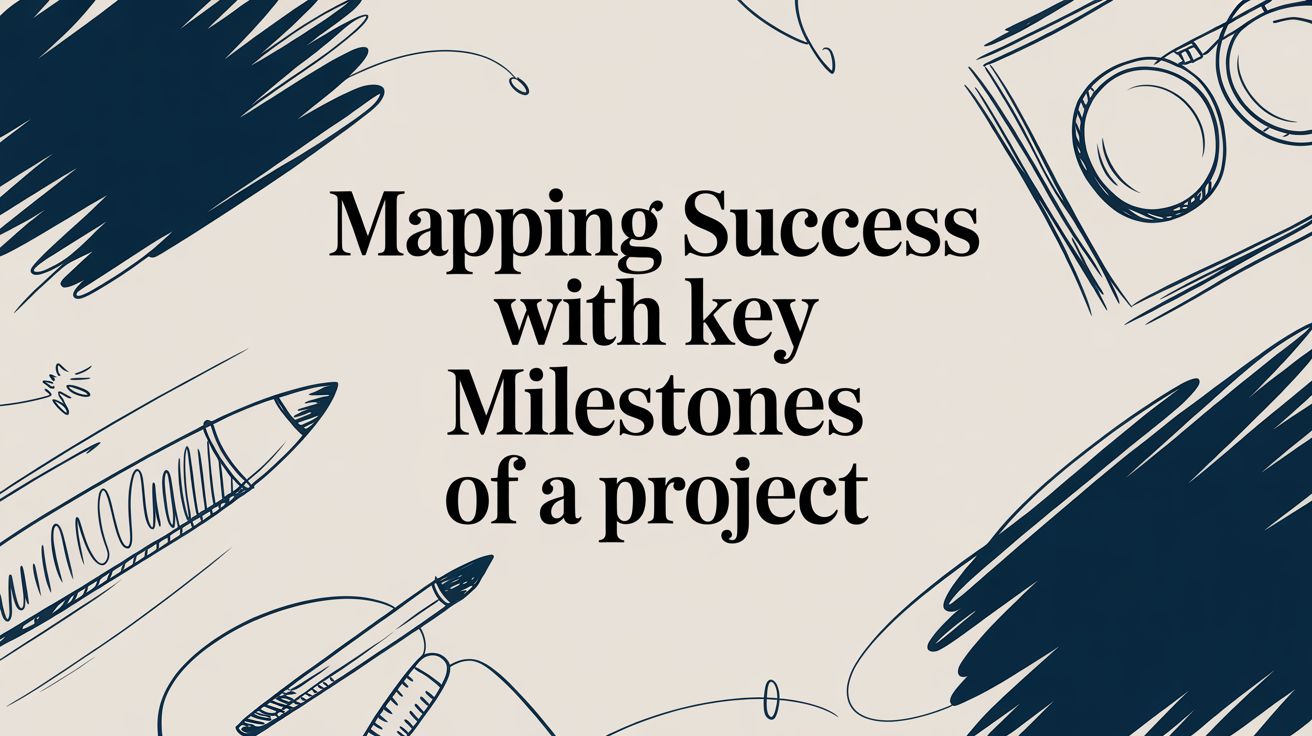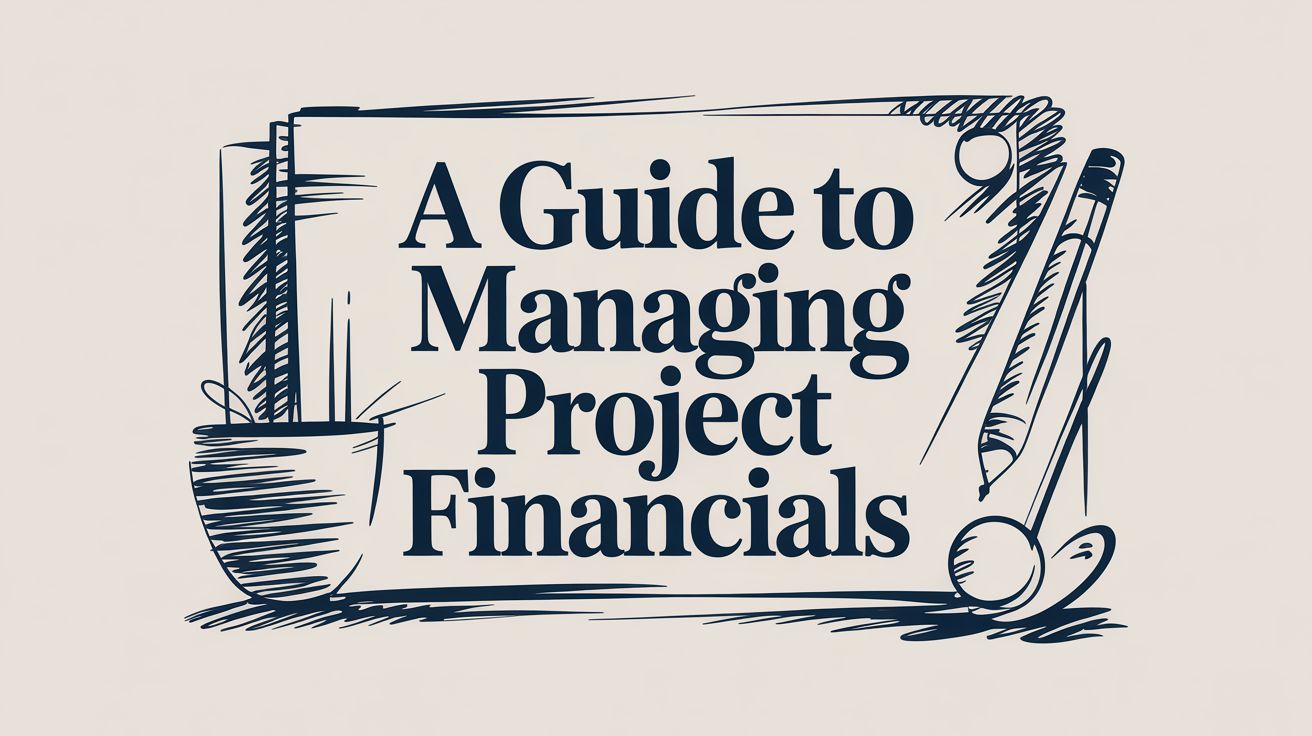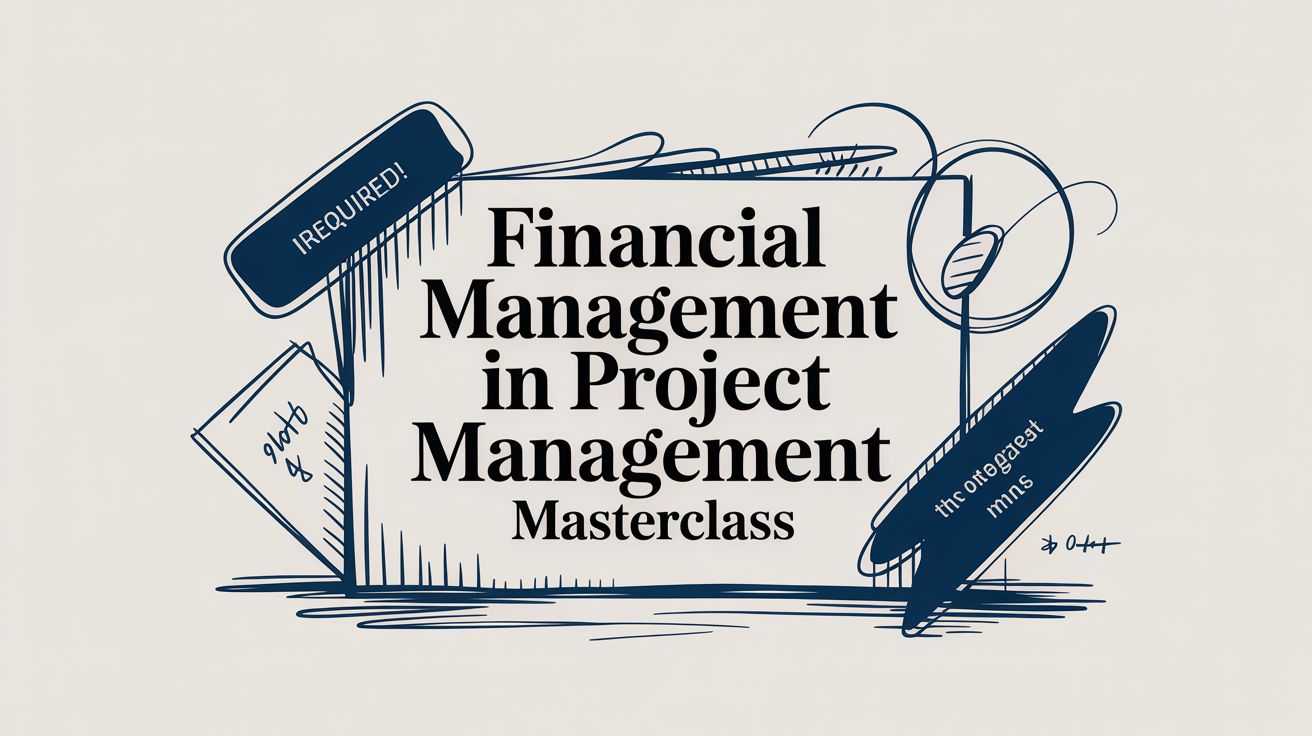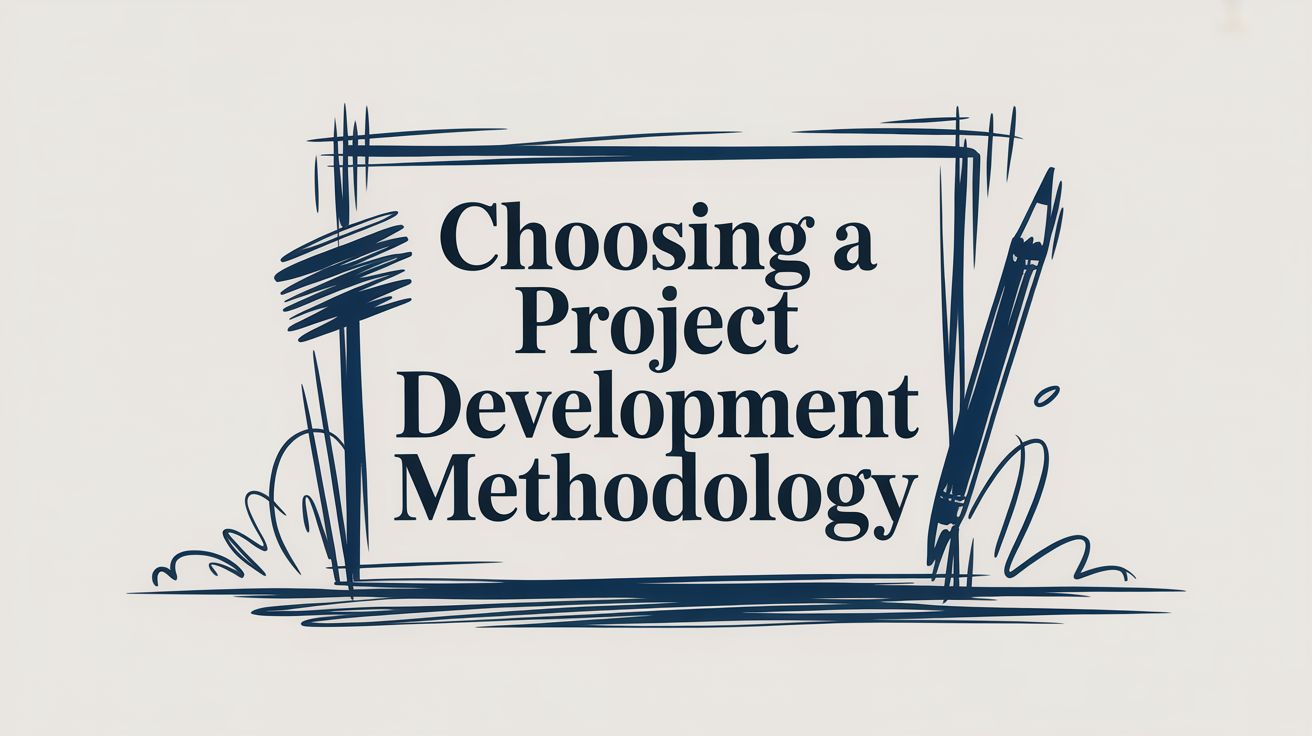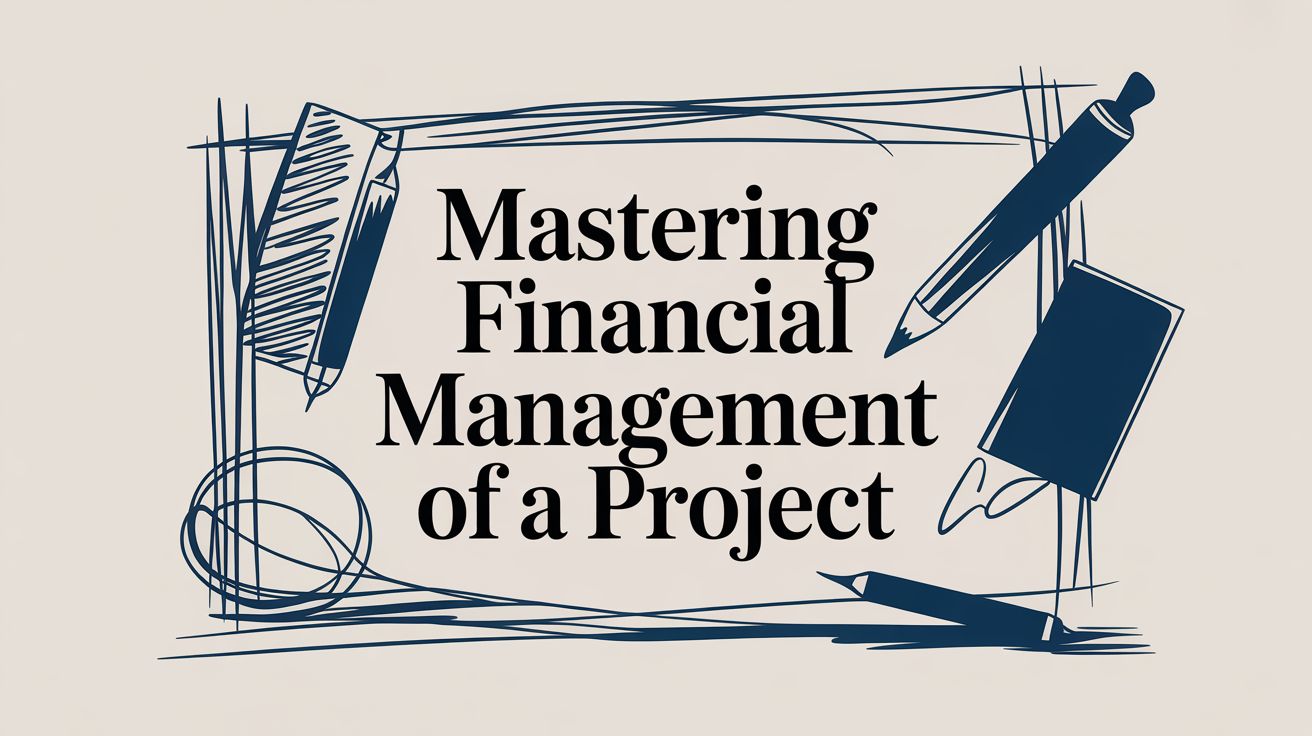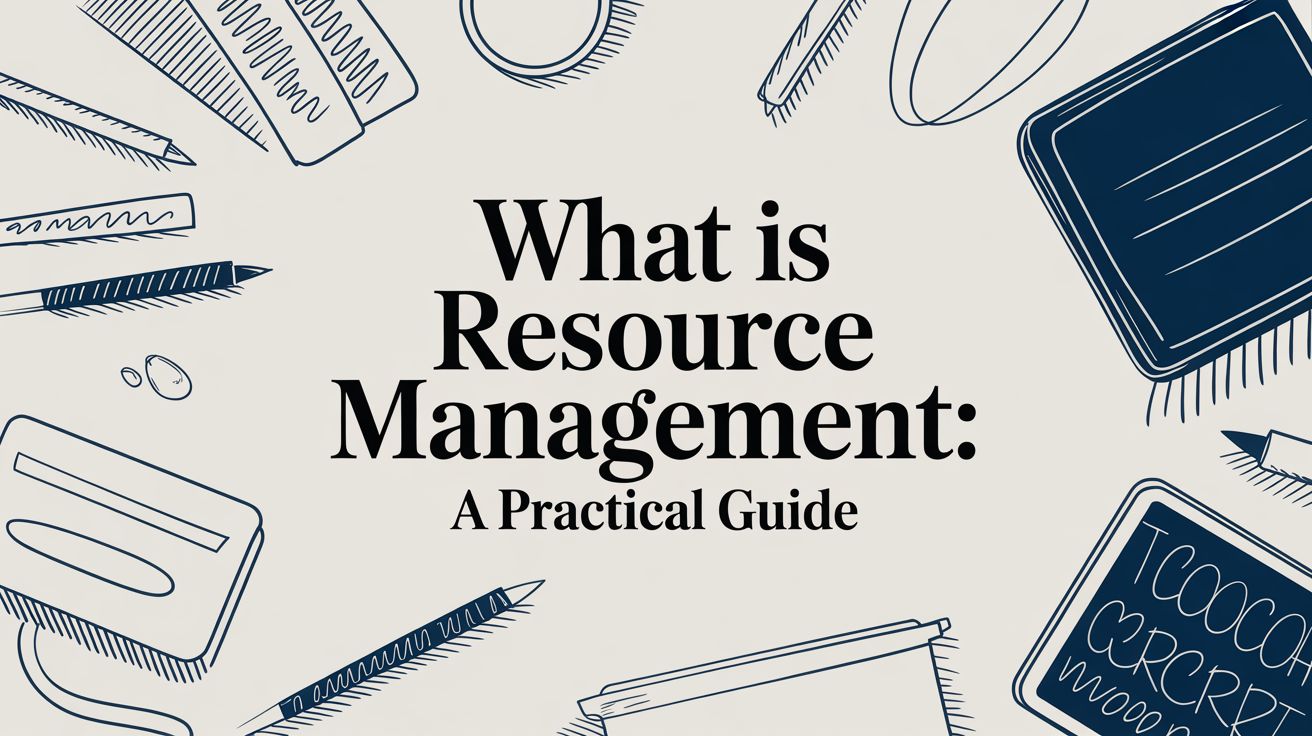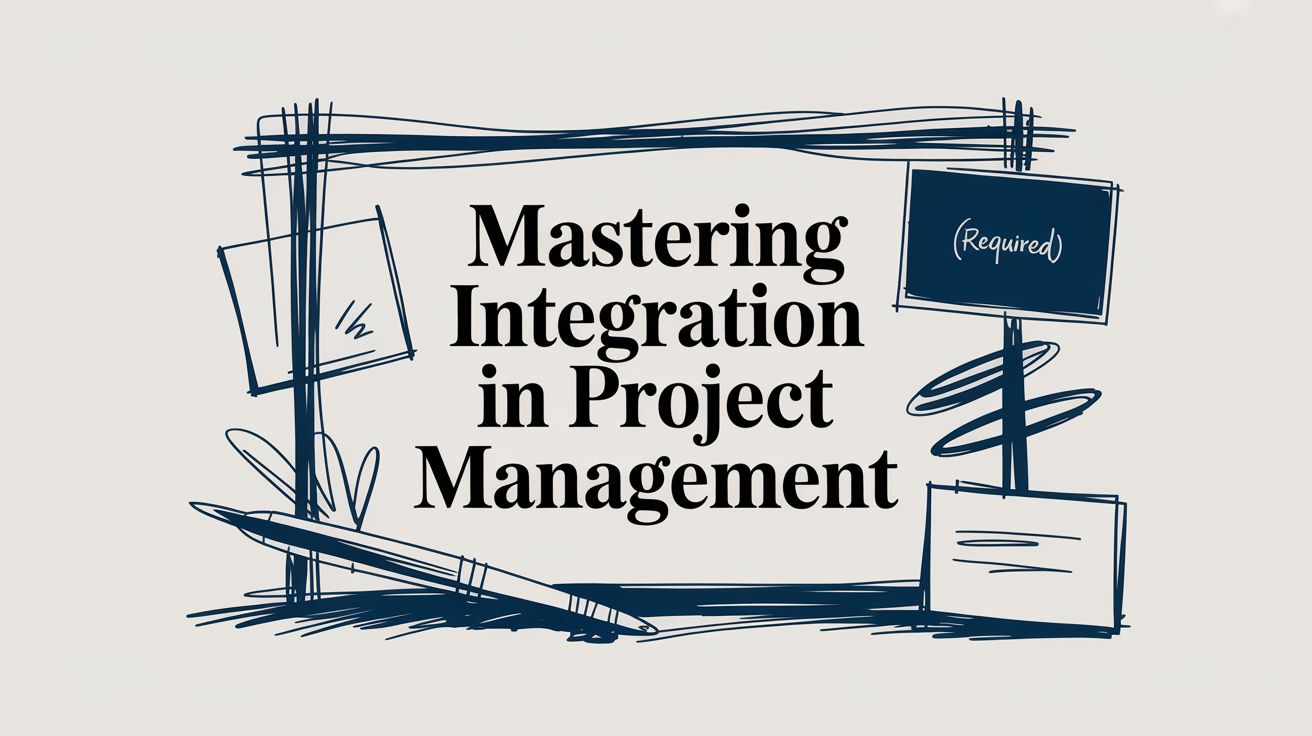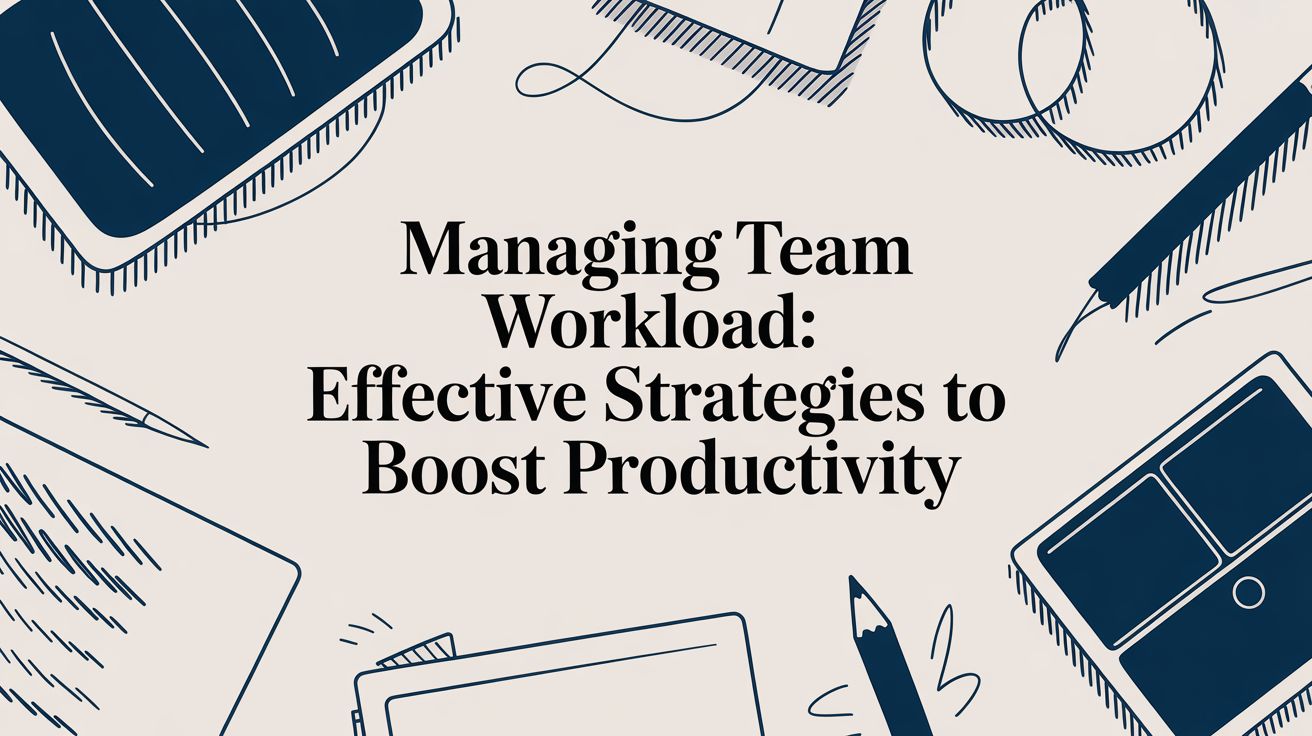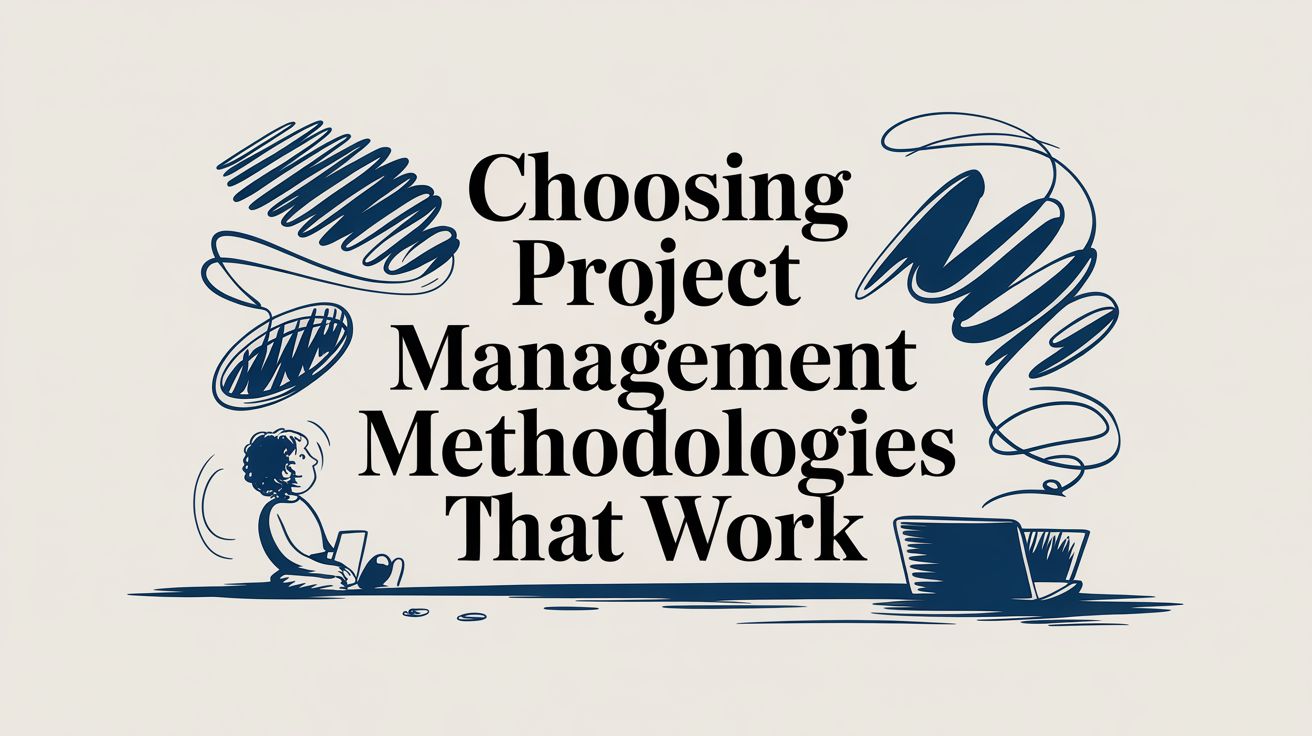It's easy to think of a milestone as just another task on your to-do list, but that’s not quite right. A milestone is a significant checkpoint, a marker that signals you’ve completed a major chunk of work.
Think of it like a long road trip. The small turns you make aren't milestones, but arriving in a major city certainly is. These big moments confirm you’re on the right track and making real, measurable progress. They bring clarity to the journey, give everyone a much-needed morale boost, and keep the whole team pointing in the same direction.
What Is a Project Milestone and Why It Matters

Let's use a classic example: building a house. Pouring the foundation is a milestone. So is completing the framing. These aren't just daily jobs; they're huge achievements that mean a distinct phase is finished and you can move on to the next one. In any project, and especially in the complex world of post-production, milestones serve this exact purpose. They take a massive undertaking and break it down into a series of high-level, manageable achievements.
This simple shift in perspective turns an overwhelming goal into a structured, step-by-step journey. To really get a feel for their importance, it helps to place them within the context of broader project management principles. Milestones act as strategic guideposts, and the benefits they bring are critical.
The Strategic Value of Milestones
At their core, milestones bring structure and visibility to a project. Without them, you’re just staring at an endless sea of tasks with no real sense of forward motion. But with them, teams have a powerful way to track progress and communicate effectively.
A few key benefits stand out:
- Enhanced Stakeholder Communication: Milestones give you a high-level snapshot of progress. This makes it super easy to update clients and executives without bogging them down in the day-to-day details.
- Improved Team Morale: There's nothing like celebrating a big win. Completing a major phase gives the team a real, tangible sense of achievement, which is fantastic fuel for the next stage of work. You can see how this fits into the bigger picture by exploring each stage of project management.
- Early Risk Detection: If you miss a milestone, it’s an immediate red flag. It tells you that the project might be slipping off schedule or hitting a snag you didn't anticipate, giving you a chance to course-correct early.
A milestone is a zero-duration event that signifies the completion of a major deliverable or a phase of the project. It has no effort or work associated with it—it is purely a marker of progress.
This isn't just theory; it applies to projects of all sizes. For example, the UK government recently gave the go-ahead to 21 major infrastructure projects in just one year. Each one is broken down by critical milestones for things like design approval, securing funding, and starting construction. On massive public undertakings like these, those markers are absolutely vital for managing budgets and public expectations.
The Anatomy of an Effective Milestone
A weak milestone is often vague, something like, “Finish video editing.” It feels like a goal, but it doesn't have the structure to be genuinely effective. A great milestone, on the other hand, is specific, verifiable, and leaves zero room for misinterpretation. It turns a simple checkpoint into a powerful strategic tool that gives you undeniable proof of progress.
Think of it like this: saying “Let’s meet in London” is an idea, but “Let’s meet under the clock at Waterloo Station at 3 PM on Friday” is a plan. An effective milestone has that same level of precision, making sure everyone on the team knows exactly what "done" looks like and when it needs to happen.
Clarity is Non-Negotiable
The single most important quality of a strong milestone is clarity. Everyone involved has to understand the conditions for its completion, without any ambiguity. It’s not a loose objective; it's a specific event you can confirm with a simple yes or no.
Look at this transformation:
- Weak Milestone: "First draft of the script is ready." (What does ‘ready’ even mean? Has it been reviewed? Is it formatted?)
- Strong Milestone: "Lead writer submits the complete, formatted first draft of the script for producer review." (Now that’s a clear, verifiable action.)
This simple shift gets rid of subjectivity and builds a solid foundation for whatever comes next. When your milestones are this clear, you avoid those dreaded “I thought you meant…” conversations that can completely throw a project schedule off track.
Ownership and Agreement are Essential
A milestone is pretty useless if no one is responsible for it. Each one needs a designated owner—a person or a specific team who is accountable for hitting that checkpoint. This clear assignment of responsibility stops tasks from falling through the cracks and ensures someone is actively pushing the work forward.
But ownership alone isn't enough. A milestone also needs buy-in from all stakeholders. This means the project manager, the team, and the client all agree on what the milestone represents and its deadline. Getting this agreement ensures everyone is aligned and pulling towards the same target.
An effective milestone is a clear, agreed-upon point in the project lifecycle that is owned by a specific individual or team. It marks a significant achievement and signals that the project can proceed to its next major phase.
Crafting these checkpoints is a core part of effective project planning, as it builds a roadmap the entire team can follow with confidence. With clear goals, assigned ownership, and universal agreement, your milestones become the bedrock of a well-managed project, moving it forward with purpose and clarity.
How to Set Milestones in Post-Production
This is where the theory hits the road. Setting milestones in a post-production schedule isn’t just about making a list of deadlines. It’s about building a logical path that creates momentum and protects the quality of your project at every single stage. Think of a well-defined milestone of the project as a checkpoint—nothing moves forward until a crucial objective has been properly met and signed off.
Let's walk through this with a typical video project. The post-production workflow naturally splits into several key phases, and for each one, we'll pin down a clear, high-impact milestone. If you're looking for detailed templates, you can find plenty of solid examples of production schedules that put these ideas into practice.
Breaking Down the Workflow
First things first, you need to map out the big stages of your post-production process. This gives you a high-level roadmap to follow.
- Phase 1: Rough Cut: This is the initial assembly of all the footage. It’s where the basic story structure takes shape.
- Phase 2: Sound Design and Mix: Time to build the audio landscape. This includes everything from dialogue and sound effects to the musical score.
- Phase 3: Colour Grading: This is where the final visual tone and look of the film are dialled in.
- Phase 4: Final Delivery: The last step—preparing and exporting the finished product for distribution.
Once you have these phases laid out, the real trick is to attach a specific, verifiable milestone to the end of each one. For example, the milestone for the rough cut isn't just "finish the edit". A much better one is "Client Approves Picture Lock." That's a concrete event. It signals that the editing phase is truly over, and no more structural changes are coming.
This kind of structured thinking is essential for managing complex projects. Take a look at large-scale public works. The UK is currently managing a massive £530 billion infrastructure pipeline made up of 780 different projects. Every single one depends on a sequence of clear milestones—from getting planning approval to the first day of construction—to keep progress and investment on track over a decade. You can read more about how this massive undertaking is managed on the Institution of Civil Engineers website.
From Phases to Actionable Milestones
With our phases defined, let's turn them into specific, actionable milestones.
- Rough Cut Milestone: Client Approves Picture Lock. This is your green light, confirming the narrative structure is locked in.
- Sound Design Milestone: Final Sound Mix Signed Off. This means every audio element is perfectly balanced and complete.
- Colour Grading Milestone: Producer Approves Final Colour Grade. This locks in the final visual feel of the project.
- Final Delivery Milestone: Master File Delivered to Client. This marks the official end of the project and handover.
This infographic breaks down what makes a milestone truly effective.
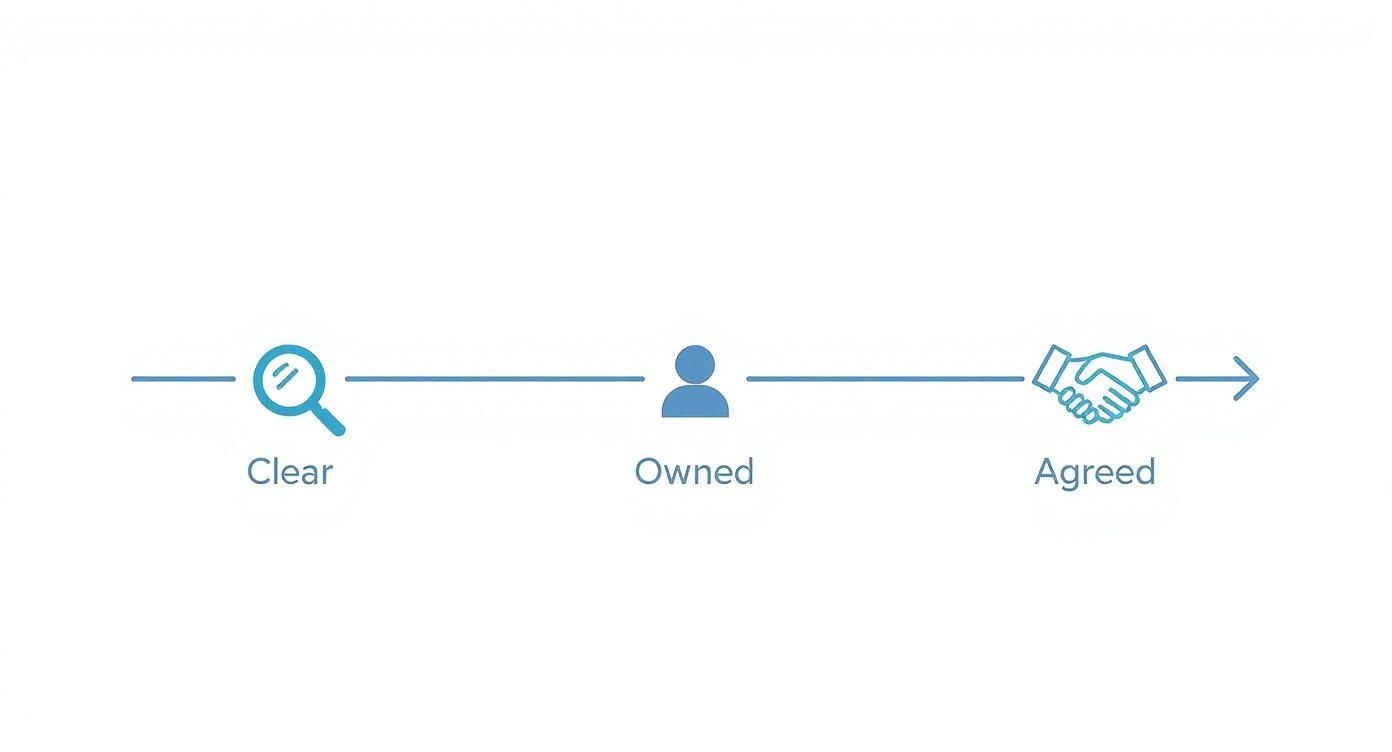
As you can see, a great milestone is crystal clear, has a designated owner, and is agreed upon by everyone involved.
Bringing your team into the milestone-setting process isn't just a nice-to-have; it's fundamental to getting it right. Your editors, sound designers, and colourists are the ones on the ground. They have the real-world expertise to set realistic timelines, making sure everyone is bought in and committed to hitting the targets they helped create.
Common Milestone Mistakes You Need to Avoid
Setting the right milestones can feel like a superpower, steering your project with clarity and purpose. But even the most experienced managers can fall into common traps, turning these powerful checkpoints into sources of confusion and frustration.
Knowing what these pitfalls are is the first step to avoiding them and keeping your project on the healthy track.
One of the most frequent errors is creating too many milestones. When every small task gets the milestone label, the whole thing just becomes a glorified to-do list. The significance gets diluted, and pretty soon, the team starts ignoring them. Think of it like a road trip where every tiny village is marked as a major city; you'd stop paying attention to the signs altogether. A milestone should always represent a significant achievement, not just another task ticked off.
Vague Goals and Missed Opportunities
Another classic mistake is setting vague or ambiguous milestones. A checkpoint like "Editing near completion" doesn't actually tell you anything. Is it 80% done? Does it mean the editor has finished a rough cut? Without a clear, verifiable definition of 'done', nobody is truly on the same page.
This lack of clarity can have serious knock-on effects. For instance, the UK has faced huge challenges with large-scale projects, where delivery times for major infrastructure initiatives shot up by 65% between 2012 and 2021. Ambiguity in early-stage milestones is a common culprit for delays like these, as different teams end up working from different assumptions. You can explore more about how the UK plans to reshape its infrastructure delivery to combat these issues and learn from past mistakes.
The opposite problem, setting too few milestones, is just as dangerous. This creates long, dark tunnels of work where the team has no real visibility of progress. Without regular checkpoints, a project can drift way off course for weeks or even months before anyone even realises there’s a problem.
Forgetting the Human Element
Finally, a surprisingly common but damaging mistake is failing to acknowledge and celebrate when a milestone is achieved. Hitting a major project milestone is a huge deal that deserves proper recognition.
- Boosts Morale: Celebrating success gives the team a powerful psychological boost, re-energising everyone for the next phase of work.
- Builds Momentum: It creates a positive feedback loop, building a culture of achievement and making the team eager to hit the next target.
- Validates Hard Work: Taking a moment to acknowledge the effort reinforces the value of every team member’s contribution.
Ignoring these wins just drains motivation and turns the project into a relentless grind. By steering clear of these common errors, you can make sure each project milestone does its job: acting as a clear, motivating, and strategic marker of genuine progress.
How Freispace Makes Milestone Management Effortless
Trying to manage project milestones with scattered spreadsheets, never-ending email chains, and a flurry of sticky notes is a recipe for pure chaos. It’s a bit like trying to navigate a cross-country road trip with a crumpled, hand-drawn map instead of a GPS. A purpose-built tool like freispace swaps that disjointed, stressful approach for a clear, seamless workflow, turning milestone theory into efficient, collaborative action.
This is where all those best practices we’ve been talking about click into place in your day-to-day operations. Instead of manually chasing down progress updates and piecing together reports, freispace pulls everything into one central hub.

The platform gives you a visual, interactive timeline where every single milestone stands out as a clear checkpoint for the entire team. This kind of visual clarity is a game-changer; everyone instantly understands what’s coming next and exactly how their piece of the puzzle contributes to the bigger picture.
Centralised Control and Automated Workflows
At its core, freispace is designed to lift the heavy administrative burden that so often comes with managing milestones. A good foundation in understanding workflow automation helps to see just how powerful this is. The platform brings smart automation to the forefront, creating a single source of truth for your entire project.
Here’s a glimpse of how it works in practice:
- Visual Timelines: You can map out your projects and define clear milestones on a Gantt-style chart. This layout makes dependencies obvious and timelines incredibly easy to adjust on the fly.
- Automated Notifications: When a deadline is creeping up or a milestone is officially hit, freispace automatically pings the relevant team members and stakeholders. No more surprises—just proactive communication that keeps everyone in the loop.
- Transparent Reporting: The platform generates progress reports automatically, making it simple to keep clients and executives informed without having to manually compile data from a dozen different places.
With freispace, the frantic question of "Where are we at with the sound mix?" is answered before it's even asked. The status is right there for everyone to see, all the time. This frees up your team to focus on their creative work instead of getting bogged down in project admin.
From Manual Tracking to Smart Management
Switching from manual methods to a dedicated tool isn’t just about getting a fancier to-do list; it’s a fundamental shift in how you oversee your projects. You’re moving from reactive problem-solving to proactive, predictive oversight that truly fosters collaboration.
To really see the difference, let’s compare the old way with the freispace approach.
Milestone Management Methods
| Feature | Manual Tracking (e.g., Spreadsheets) | Using freispace |
|---|---|---|
| Visibility | Fragmented and often out of date. | Centralised, real-time project overview. |
| Communication | Reactive and requires constant manual updates. | Proactive with automated notifications and reports. |
| Accountability | Murky and difficult to track who owns what. | Crystal clear with assigned owners for every task. |
| Risk Detection | Slow, with issues often spotted after the fact. | Fast, with potential delays flagged well in advance. |
By bringing everything together into one organised space, freispace ensures your entire team is always on the same page. What was once a complex coordination challenge becomes a smooth, predictable process. This is how you make sure every single project milestone is hit on time and on budget, every time.
The True Impact of Effective Milestone Tracking
Getting a handle on your project milestones is about so much more than just ticking boxes. When you manage them properly, the positive effects ripple out across your entire post-production workflow, building a powerful current of trust, momentum, and team morale that carries a project right through to a successful finish.
Think of it this way: solid milestone tracking builds unshakable trust. When clients and stakeholders see you consistently hitting key targets, their confidence in the project—and in you—grows. This kind of transparency turns a simple client relationship into a genuine partnership, because they can clearly see everything moving forward exactly as promised.
An Early Warning System for Risk
Well-defined milestones also serve as a brilliant early warning system. Missing a key deadline isn’t just a small hiccup; it’s a bright red flag that something, somewhere, has gone off track.
This gives you a chance to jump in, figure out what’s wrong, and adapt your plan long before a minor issue snowballs into a full-blown crisis that threatens your budget and timeline. These checkpoints are your built-in moments for course correction.
Ultimately, this isn't just about managing tasks—it's about leading with clarity. Every milestone you hit is tangible proof of your team's dedication and another concrete step toward a brilliant final delivery.
Fuelling Team Morale and Momentum
Maybe the most important impact is the human one. Let's be honest, long post-production schedules can feel like a marathon with no end in sight. Celebrating a major milestone gives your team a much-needed shot in the arm and validates all their hard work.
- It creates a culture of achievement: When you make a habit of hitting and acknowledging milestones, you build a positive environment where success becomes the standard.
- It provides that crucial momentum: Every win gives the team the energy and drive to dive into the next phase with fresh focus.
This builds a powerful sense of accomplishment that fuels your crew all the way to the finish line.
Frequently Asked Questions
Even once you get the hang of project milestones, a few practical questions always seem to come up. We've gathered some of the most common ones we hear and answered them in a clear, straightforward way to help you manage your milestones with confidence.
These aren't just theoretical answers; they tackle the real-world scenarios you’ll actually face, from setting up your first timeline to handling those inevitable last-minute changes.
How Many Milestones Should a Project Have?
There's no magic number here. The right amount really depends on how complex your project is and how long it’s scheduled to run.
For a simple, two-week job, you might only need two or three key markers, like "Initial Creative Approved" and "Final Files Delivered." But for a massive six-month post-production schedule, you could easily have ten to fifteen distinct milestones to keep everything on track.
A good rule of thumb is to set a milestone for the end of each major work phase. If your milestones are more than a month apart, you’re probably flying blind. On the flip side, if they're popping up every other day, you're likely confusing simple tasks with major achievements, which just dilutes their meaning.
What Is the Difference Between a Milestone and a Deadline?
This is a really important distinction to get right. Think of it like this: a deadline is the 'when,' and a milestone is the 'what.'
A deadline is just a date on the calendar. It’s a time constraint telling you when a task, or a set of tasks, has to be finished.
A milestone, however, is a significant event. It marks the completion of a major deliverable or phase. It has zero duration itself—it’s that specific moment of achievement.
Here’s a practical example:
- Deadline: All colour grading tasks must be wrapped up by Friday at 5 PM.
- Milestone: Client sign-off on the final colour grade is achieved.
See the difference? The deadline creates the pressure to get the work done, while the milestone confirms it was completed successfully.
How Should You Adjust Milestones When Project Scope Changes?
Scope creep is a reality for just about every project, and your milestones need to be flexible enough to adapt. When a project's scope changes, the first thing to do is hit pause and figure out how it affects your existing milestone map.
Adding a new major deliverable almost always means adding a new milestone to your timeline.
Don't just try to cram the new work in between existing checkpoints. The right way to handle it is to formally revise the project plan with your team and any stakeholders. That process looks something like this:
- Identify exactly what new tasks are needed.
- Create a new, logical milestone that represents the completion of that extra work.
- Adjust the deadlines for all the following milestones to account for the additional effort.
- Communicate these changes clearly to everyone involved. This keeps everyone aligned and avoids any nasty surprises.
Handling scope changes this formally prevents your timelines from quietly spiralling out of control.
Ready to stop juggling spreadsheets and start managing milestones with real clarity? freispace provides the visual timelines and automated workflows you need to keep every project on track. See how it works at freispace.com.

